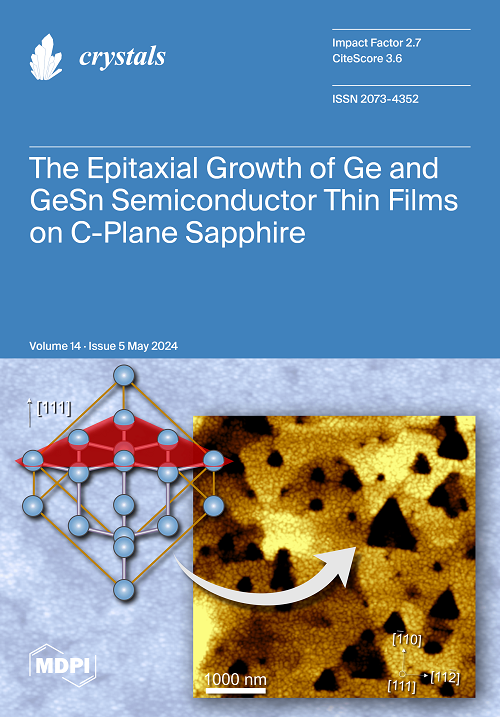Synthesis and Investigation of ReSe2 Thin Films Obtained from Magnetron Sputtered Re and ReOx
IF 2.4
4区 材料科学
Q2 CRYSTALLOGRAPHY
引用次数: 0
Abstract
The promise of two-dimensional (2D) rhenium diselenide (ReSe2) in electronics and optoelectronics has sparked considerable interest in this material. However, achieving the growth of high-quality ReSe2 thin films on a wafer scale remains a significant challenge. In this study, we adopted a two-step method to produce ReSe2 thin films by combining magnetron sputtering of Re and ReOx onto flat substrates with subsequent selenization via atmospheric pressure chemical vapor transport (CVT). After analyzing the produced films using X-ray diffraction to identify the crystalline phase in formed thin film and scanning electron microscopy (SEM) to examine surface morphology, it was determined that the suitable temperature range for the 15 min selenization process with CVT is 650 °C–750 °C. Further investigation of these optimally produced ReSe2 thin films included atomic force microscopy (AFM), X-ray photoelectron spectroscopy, and Raman spectroscopy. The bulk electrical analysis of these films and AFM and SEM surface morphology revealed a strong reliance on the type of precursor material used for their synthesis, whereas optical measurements indicated a potential for the films in non-linear optics applications, irrespective of the precursor or temperature used. This study not only provides a new pathway for the growth of ReSe2 films but also sheds light on the synthesis approaches of other 2D transition metal dichalcogenide materials.磁控溅射 Re 和 ReOx 生成的 ReSe2 薄膜的合成与研究
二维二硒化铼(ReSe2)在电子和光电子领域的应用前景引发了人们对这种材料的浓厚兴趣。然而,如何在晶圆规模上生长出高质量的 ReSe2 薄膜仍然是一项重大挑战。在这项研究中,我们采用了一种两步法,将 Re 和 ReOx 结合磁控溅射到平面基底上,然后通过常压化学气相传输(CVT)进行硒化,从而制备出 ReSe2 薄膜。在使用 X 射线衍射法分析所生产的薄膜以确定所形成薄膜中的结晶相,并使用扫描电子显微镜(SEM)检查表面形貌后,确定使用 CVT 进行 15 分钟硒化过程的合适温度范围为 650 ℃-750 ℃。对这些优化生产的 ReSe2 薄膜的进一步研究包括原子力显微镜 (AFM)、X 射线光电子能谱和拉曼光谱。这些薄膜的体电学分析以及原子力显微镜和扫描电子显微镜的表面形态显示,这些薄膜的合成与所使用的前驱体材料类型有很大关系,而光学测量则表明,无论使用哪种前驱体或温度,这些薄膜都具有在非线性光学领域应用的潜力。这项研究不仅为 ReSe2 薄膜的生长提供了一条新途径,还为其他二维过渡金属二掺杂材料的合成方法提供了启示。
本文章由计算机程序翻译,如有差异,请以英文原文为准。
求助全文
约1分钟内获得全文
求助全文
来源期刊

Crystals
CRYSTALLOGRAPHYMATERIALS SCIENCE, MULTIDIS-MATERIALS SCIENCE, MULTIDISCIPLINARY
CiteScore
4.20
自引率
11.10%
发文量
1527
审稿时长
16.12 days
期刊介绍:
Crystals (ISSN 2073-4352) is an open access journal that covers all aspects of crystalline material research. Crystals can act as a reference, and as a publication resource, to the community. It publishes reviews, regular research articles, and short communications. Our aim is to encourage scientists to publish their experimental and theoretical results in as much detail as possible. Therefore, there is no restriction on article length. Full experimental details must be provided to enable the results to be reproduced. Crystals provides a forum for the advancement of our understanding of the nucleation, growth, processing, and characterization of crystalline materials. Their mechanical, chemical, electronic, magnetic, and optical properties, and their diverse applications, are all considered to be of importance.
 求助内容:
求助内容: 应助结果提醒方式:
应助结果提醒方式:


